文房四宝英语介绍
- 格式:pptx
- 大小:2.33 MB
- 文档页数:18
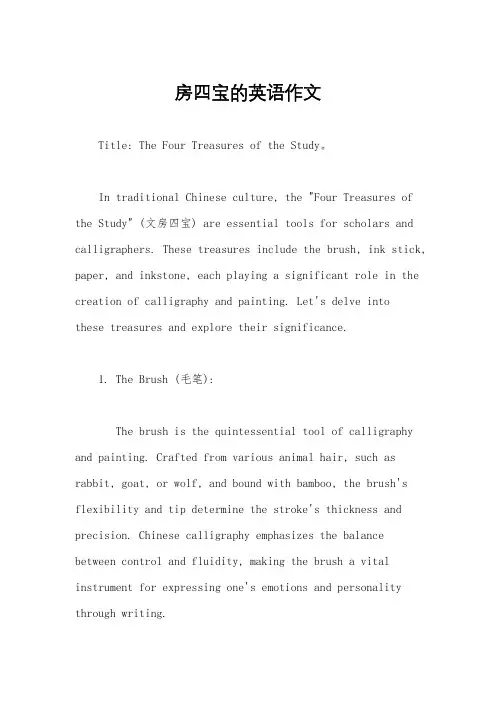
房四宝的英语作文Title: The Four Treasures of the Study。
In traditional Chinese culture, the "Four Treasures of the Study" (文房四宝) are essential tools for scholars and calligraphers. These treasures include the brush, ink stick, paper, and inkstone, each playing a significant role in the creation of calligraphy and painting. Let's delve intothese treasures and explore their significance.1. The Brush (毛笔):The brush is the quintessential tool of calligraphy and painting. Crafted from various animal hair, such as rabbit, goat, or wolf, and bound with bamboo, the brush's flexibility and tip determine the stroke's thickness and precision. Chinese calligraphy emphasizes the balance between control and fluidity, making the brush a vital instrument for expressing one's emotions and personality through writing.2. The Ink Stick (墨):The ink stick, traditionally made from pine soot and animal glue, is essential for producing ink. To create ink, the ink stick is rubbed against an inkstone with wateruntil it forms a smooth, velvety texture. The quality of the ink depends on the skillful grinding technique and the ink stick's quality. In Chinese culture, the act of grinding ink is not merely a practical task but also a meditative practice, symbolizing the scholar's dedication to their craft.3. The Paper (纸):Chinese rice paper, known as "Xuan paper," is renowned for its absorbency and durability, making it the preferred choice for calligraphy and painting. Xuan paper comes in various thicknesses and textures, each suited for different artistic styles and techniques. Beyond its practical use, paper holds symbolic significance, representing the blank canvas upon which the artist'screativity flourishes.4. The Inkstone (砚):The inkstone serves as the vessel for grinding ink and is often carved with intricate designs or auspicious symbols. Made from stone, such as slate or Shoushan stone, the inkstone is prized for its smooth surface and abilityto preserve the ink's quality. Beyond its utilitarian function, the inkstone embodies the harmony between nature and art, as it is crafted from materials sourced from the earth.Together, these Four Treasures of the Study symbolizethe essence of Chinese culture and artistic expression.They embody the values of discipline, patience, and mastery, reflecting the scholar's journey towards enlightenment and self-expression. In a world dominated by digital technologies, the enduring significance of thesetraditional tools reminds us of the timeless beauty and richness of our cultural heritage. As we cherish and preserve these treasures, we honor the legacy ofgenerations past and inspire future generations to continue the tradition of artistic excellence.。

文房四宝的故事简介英语介绍The Four Treasures of the Study, also known as "Wen Fang Si Bao," is a term that encapsulates the essential tools of traditional Chinese calligraphy and painting: the brush, ink, paper, and inkstone. Each element is steeped in history and has played a pivotal role in the artistic and cultural expression of China.The brush, often made from animal hair, is a delicate instrument that requires a skilled hand to wield. It allows for a wide range of strokes, from the thinnest lines to the boldest sweeps, capturing the essence of the artist's intent.Ink, a product of soot and animal glue, is a medium that has been refined over centuries. Its rich black color is a stark contrast against the white of the paper, creating a striking visual impact that is instantly recognizable.Paper, traditionally made from mulberry bark, has a unique texture that absorbs ink differently depending on its quality and thickness. It is this interaction between ink and paper that gives Chinese calligraphy its distinctive look.Lastly, the inkstone, a solid block of stone with a well for holding water, is where the ink is ground to the desired consistency. This process is as much a part of the art as the actual writing or painting itself.Together, these Four Treasures form the backbone of Chinese calligraphy and painting, each element contributing to the creation of timeless works of art that continue to inspire and captivate audiences around the world.Over time, the Four Treasures have become more than just tools; they are symbols of Chinese culture and tradition. They represent the harmony between nature and art, and the pursuit of perfection in every stroke.In the hands of a master, the Four Treasures come alive, transforming a blank sheet of paper into a canvas of profound beauty and meaning. It is through these tools that the spirit of Chinese art is preserved and passed down through generations.Despite the advent of modern technology, the Four Treasures remain a testament to the enduring legacy of traditional Chinese art. They serve as a reminder of the importance of preserving cultural heritage and the value of craftsmanship in a rapidly changing world.。

文房四宝英语作文80词The Four Treasures of the Study, also known as 文房四宝(wén fáng sì bǎo) in Chinese, refer to the essential tools used in traditional Chinese calligraphy and painting. These treasures are the brush (毛笔, máo bǐ), ink stick (墨, mò), paper (纸, zhǐ), and ink stone (砚台, yàntái). They hold cultural significance and are deeply intertwined with Chinese artistic and literary traditions.The brush, made from animal hair such as rabbit, wolf, or goat, is essential for calligraphy and painting. Its flexibility and precision make it a crucial tool forartists and writers alike.The ink stick is crafted from soot and animal glue, compressed into a solid form. To use it, one grinds it against an ink stone, adding water gradually to achieve the desired consistency. This ritualistic process is not only practical but also meditative, embodying the spirit of patience and discipline.Paper, traditionally made from bamboo fibers or rice straw, is highly absorbent and durable, making it suitable for calligraphy, painting, and even printing. Its smooth surface allows for fluid brushwork and crisp lines.The ink stone serves as a surface for grinding the ink stick and mixing ink. Carved from stone, it often features intricate designs and motifs. The process of grinding ink on the stone requires skill and precision, reflecting the reverence for craftsmanship in Chinese culture.Together, these Four Treasures embody the essence of Chinese culture and artistic expression. They represent the harmony between human creativity and the natural world, as well as the values of diligence, patience, and reverencefor tradition. Through their use, artists and writers connect with centuries of heritage and continue to innovate within a rich cultural legacy.。
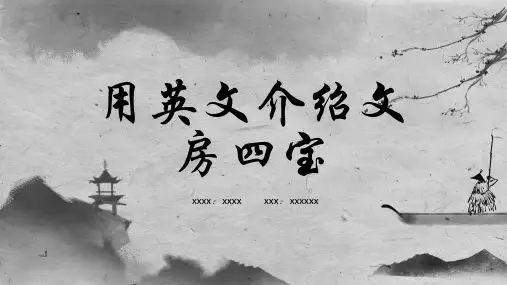



如何用英语介绍文房四宝本篇介绍“笔墨纸砚”这四宝。
现在我们来谈谈中国画作画时常用的工具。
Now let’s talk about the things, or the tools we are gonna use to paint Chinese painting.我们把这些工具称作“文房四宝”,意思就是书房里的四件宝物。
In Chinese we called those tools as “Wen Fang Si Bao”,literally means the four treasures in your study.这些是毛笔,我们叫做“笔”。
These are the brush, we call'em “Bi”.这是“墨”。
And this is ink.这是“纸”。
And this is, of course, paper, you can see that.这块石头是“砚”,叫做砚石或砚台。
And this piece of stone we call it ink stone or ink slap.这件我们叫做“笔”的东西,在英语中叫做“刷子”。
The thing is that, this is called “Bi” in Chinese. But of course I see that in English it’s called brush.在西方绘画中,你们用扁平的刷子,但在中国绘画和书法中,我们用圆形的刷子。
In western painting, you use a kind of a flat brush, but in Chinese painting or Chinese calligraphy, we use a round one.在中文中我们说的笔,听起来与英文中的,“钢笔”是一样的。
And in Chinese we call it “Bi”, which sounds very much like or exactly the same as we would call it pen in English.所以这是很传统的“中国笔”。
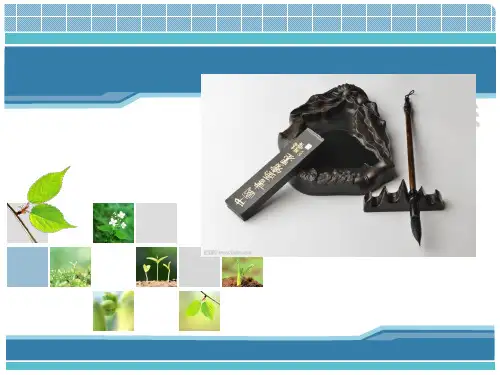
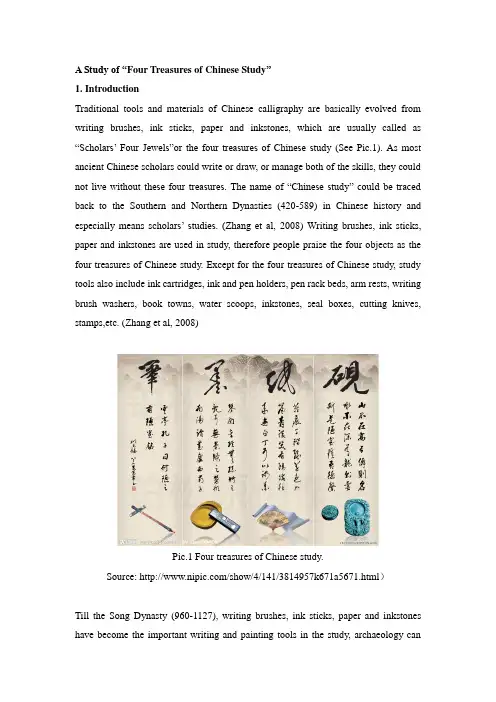
A Study of “Four Treasures of Chinese Study”1. IntroductionTraditional tools and materials of Chinese calligraphy are basically evolved from writing brushes, ink sticks, paper and inkstones, which are usually called as “Scholars’ Four Jewels”or the four treasures of Chinese study(See Pic.1). As most ancient Chinese scholars could write or draw, or manage both of the skills, they could not live without these four treasures. The name of “Chinese study” could be traced back to the Southern and Northern Dynasties (420-589) in Chinese history and especially means schola rs’ studies. (Zhang et al,2008) Writing brushes, ink sticks, paper and inkstones are used in study, therefore people praise the four objects as the four treasures of Chinese study. Except for the four treasures of Chinese study, study tools also include ink cartridges, ink and pen holders, pen rack beds, arm rests, writing brush washers, book towns, water scoops, inkstones, seal boxes, cutting knives, stamps,etc. (Zhang et al, 2008)Pic.1 Four treasures of Chinese study.Source: /show/4/141/3814957k671a5671.html)Till the Song Dynasty (960-1127), writing brushes, ink sticks, paper and inkstones have become the important writing and painting tools in the study, archaeology canalso prove it. For instance, in the tomb of Xu Jun of the Southern Song Dynasty in Fouzhou city, Fujian Province, researchers found the whole set of the four treasures of Chinese study as burial objects. (Zhang, 2004) Another example is that on the wall painting Zhang Wenzao’s family tomb in the Liao Dynasty in Zhangjiakou, Hebei Province, there are several images about the writing brushes, ink sticks, paper and inkstones. These facts present that the four treasures have gradually formed a broad social practical basis in such a long history and finally became a special word in the Song Dynasty. (Zhang et al, 2008)In order to know and resume the relations between ancient writing and painting tools with the study and the scholars’behavior, people should fully understand the main line of the development of calligraphy tools. This paper will make an in-depth historical research on the four treasures of Chinese study, analyze the historical development and characteristics of the four tools, besides, the author will also conduct a series of case studies of the most famous representatives in China and their advantages.2.Writing brushPic.2 Writting BrushesSource: /2011/14/111419/images/bi3.jpgWriting brush ranks the first of the four treasures of the study. It is said that it was invested by famous general Meng Tian of Qin Dynasty. Traditional writing brushes are not only the necessary stationary of ancient Chinese people, but also have extraordinary charm in expressing Chinese calligraphy and painting. (Zhang, 2004)However, as writing brushes are easy to be damaged, there is few ancient writing brushes conserved till now.There are many kinds of writing brushes. In terms of the materials, many animals’hair are used such as rabbits, goats, deer, mice, tigers, gorillas, ducks, geese, chicken, pigs even humans.From the performance’s perspective, writing brushes can be classified into rigidity brush, flexible brush and doubled both brush. As for the material of barrel, different varieties of bamboos and wood, even crystal, horn, jade, gold, silver are used. (Zhang, 2004)The most famous writing brush producing area in China is Huzhou City, Zhejiang Province. Writing brushes made in Huzhou is called Hu writing brush. Hu writing brushes are made of high quality materials with exquisite techniques. (He, 2008) The four major characteristics are "pointed tip, uniform hair, perfect roundness and resilient to the touch. Hu writing brush has four types: goat hair, wolf hair, mixed hair and rabbit hair. According to the size, there are huge, big, middle and small. (Chen,2004)Shen Zhaomin is a contemporary calligrapher from Huzhou, he is well-known her using a huge Hu writing brush to write calligraphy.He has devoted numerous effort practicing calligraphy for decades and does excellent in all kinds of calligraphies. In 2001, he used a special Hu writhing brush which was as heavy as 81.5kg, to write down the word “Hu writing brush”which had an area of around 600㎡,and got the Guinness World RecordsCertificate of Calligraphy with Huge Brush. On the closing ceremony of Doha Asian Games, he used a 25kg Hu writing brush to write down “Harmonious Asia”on four big yellow satin cloths. (See Pic.3) Although the performance only lasted six minutes, every second was astonishing. Master Shen represented the magic Chinese calligraphy to the whole world, which was a never forgettable scene of all audience. (He,2008)Pic. 3 Shen Zhaomin is writing “harmonious Asian”in Chinese calligraphy using a 25kg Hu writing Brush, Doha Asian Olympic Games, 2005Source: /News_View.asp?NewsID=4953.Ink stickInk brings people a relatively monotonous impression, however without this kind of unique material, the fantastic artistic conception of traditional Chinese calligraphy cannot be realized. Actually the world of ink has quite abundant connotation. Before the invention of artificial ink, people generally used natural ink as writing material.(Zeng,1993) On some prehistoric pottery, bamboo and wooden slips, there are signs of primitive ink.Till the Han Dynasty, artificial ink appeared. The raw materials came from turpentine soot and squeezed by hands or molded. Till the Wei, Jin, the Southern and Northern Dynasties, the quality of ink constantly improved. (Zhang, 2004)Ink is divided into two types: pine-soot ink and oil-soot ink. Pint-soot ink is made of pine wood’s ash. The characteristics of it are black, low glossiness, light colloid, so itis only suitable for writing. While the oil-soot ink is made from animal or plant oil. It usually has bright color and is perfect for traditional Chinese painting. The ink of Chinese painting is generally in the form of ink sticks. According to the uses of ink sticks there are common ink, tribute ink, royal ink, home-made ink, gift ink etc. (Zeng,1993)Pic 4. The Hui Ink StickSource: /GB/8215/54394/54397/3796434.htmlThe Hui Ink Stick is the most famous ink stick product in China. Its was named after its production area ancient Huizhou. Today, Tunxi District and Xi County in Huangshan city, Anhui Province are the two manufacturing centers of Hui Ink Sticks.There are various types of Hui Ink Stick, such as paint-soot, oil-soot,net-soot, minus-glue, added-spice etc. The high class paint soot ink sticks are made from ten kinds of precious materials including Tung oil-soot, musk, borneol, gold foil and pearl powder. Hui Ink Sticks have the advantages of light weight, pleasant odor, hard quality, long-lasting effect etc, therefore, it has become calligraphers and painters’necessary goods for hundreds of years. (See Pic 4)Pic 5. Workers are making Hui Ink SticksSource: /wfsb/20080820-12530/The production of Hui Ink Stick has a history of one thousand years. The ink sticks are the combination of drawing, calligraphy, carving, shaping etc, thus become a kind of comprehensive artistic treasure. In contemporary times, Hui Ink Stick is developed and updated on the basis of traditional craftsmanship. (See Pic 5) However, due to the lack of raw materials and the inheritors, the future of Hui Ink Stick is worrying. (Chen,2004)4. PaperPaper is one of the four great inventions in ancient China. It is said that Cai Lun of the East Han Dynasty updated the technology of making paper, thus improved the quality of paper, made paper easier to write on. Till Wei and Jin Dynasties, paper fully replaced other materials and became the main writing material. Since then,the position of paper has never been threated. (Zhang, 2004) From this point, paper has the largest vitality among the four treasures of Chinese study. For ancient Chinese people, paper is a tool to be relaxed and pleased, a carrier to point out problems and the bailment of emotions. For most Chinese, paper is a concentration of Chinese culture and history.People believe that the Xuan Paper is the best paper to write and draw. Xuan Paper is produced in Jin County, Anhui Province, which is a kind of high class artistic paper used for traditional Chinese brush calligraphy, painting, mounting, rubbing, watermarking etc. Till now, Xuan Paper has a history of over one thousand years. (Zeng,1993) Xuan Paper has excellent ink embellishment, durability, non-deformation and insect resistance, thus it has become the paper which could best present the artistic style of traditional Chinese painting and calligraphy. (Chen, 2004) It is said that ink can be divided into five colors, which means one stroke contains deep and light colors, the layers and patterns are quite clear. This trick is created by artists using the ink embellishment feature of Xuan Paper to control the proportion of water and ink. A large amount of ancient artistic works and literature spread up to now arepreserved by Xuan Paper perfectly.Pic 6. Xuan Paper in manufacturing/wenzhang/11013/1101391747.html)In terms of the manufacturing methods, Xuan Paper is classified into untreated Xua n Paper, treated Xuan Paper and semi-treated Xuan Paper. (See Pic6) Untreated Xuan Paper includes Jiagong, Yuban, Jingpi, Danxuan, Mianlian etc. (Zhang, 2004) Untreated paper refers to the paper without manufacturing, it has strong water-absorbing quality and water permeability,so it is easy to produce abundant ink changes and achieve fantastic artistic effect. When people draw enjoyable scenery, they will use this kind of Xuan Paper. Treated Xuan Paper is the deep manufacturing product of untreated Xuan Paper. It is made of the combination of untreated paper and a special glue. The manufacturing process of treated Xuan Paper is easy and convenient o manage. However the proportion of glue and alum has no certain standard, it should be determined according to requirement of painting and calligraphy, and the quality of paper. Different proportion will directly influence the final effects of manufacturing. (Zhang, 2004)5. InkstoneInkstones are the containers of ink. Most of inkstones are made of stones, some of inkstones are made of earthenware clay. Inkstone have various shapes includingrectangular, square, circle, oval and bionic shapes such as animals and plants. Sometimes craftsmen carve all kinds of decorations on the bodies of inkstones. High class inkstones have the characteristics of exquisite smooth and quality, grinded ink is fine and well-distributed. Famous inkstones are divided into Duan and Xi. (Zhang,2004) Except for practical use, inkstones are also very valuable art crafts and valued by collectors and scholars.Overall, the development of inkstones is a process from pursuing the practical functions to pursuing aesthetic joy. Before the Tang Dynasty, people mainly developed the practical functions of inkstones, the shapes were mostly simple and rustic without any decorations. (Yen, 2013) At first, people could not be certain that which material is most suitable for inkstone making, so they tried all possible materials including stone, pot clay, paint, jade, china etc. Till the Tang Dynasty, people finally determined the main body position of stone inkstones, and gradually developed four important series of inkstone products which were Duan, Xi, Hongsi and Chengni, and basically perfected the practicability of inkstones. Since the Song Dynasty, the development of inkstones gradually became the pursuit of aesthetic joy. At that stage, many professional literature were released including the quality, style, carving technique of inkstones, such as the History of Inkstones written by Mi Fu, Record of Inkstones written by Su Yijian, thus have laid a foundation for the future development of inkstones. (Dong et al, 2008)Pic 7 Duan InkstoneSource: /tour/ShowArticle.aspx?ArticleID=537)The Duan Inkstone has the highest reputation among all kinds of inkstones. (See Pic 7) Duan Inkstone is produced in ancient Duanzhou in Guangdong Province. It became nationally renowned as early as the Tang Dynasty, The quality of Duan Inkstone is very lubricating and exquisite. (Xiang, 2008) Most of Duan Inkstones have the color of purple and some yellow, red or green circle patterns, which are called eyes. Duan Inkstone has been produced since the beginning of the Tang Dynasty. Since the middle of the Tang Dynasty, people began to pay attention to the pattern carving, thus Duan Inkstone has transformed form stationary into art craft. Till the Song Dynasty, the emperor listed Duan Inkstone as one of the tributes. (Xiang,2008) Nowadays, due to the lack of scientific management, the stone pits around Zhaoqing have been severely damaged, therefore Duan Inkstone has become more precious than ever.6.ConclusionAll in all, this paper has made an in-depth analysis of the four treasures of Chinese study respectively which are writing brushes, ink sticks, paper and inkstones. Not only has the author discussed the historical development and characteristics of the four tools, but also conducted a series of case studies of the most famous representatives in China and their advantages including Hu Writing Brush, Hu Ink Stick, Xuan Paper and Duan Inkstone. The four treasures of Chinese study have created numerous value for ancient Chinese culture including calligraphy, painting, sealing, and the preservation of historical literature and materials. They are of important practicability as well as aesthetical value. It is people’s responsibility to pass the four treasures generation after generation, maintain, update them and promote them to the whole world.References:Dong, J., Xu, M., Zhang, X. J., Gao, Y. Q., & Pan, Y. H. 2008. The creation process of Chinese calligraphy and emulation of imagery thinking. Intelligent Systems, IEEE, 23(6), pp. 56-62.Xiang, H. E. 2008. A Perspective of Inkstone Culture under Protection of Non-Material Cultural Heritage——Take Zhaoqing'S Duan Ink Slab as an Example. Journal of South-Central University for Nationalities (Humanities and Social Sciences), 3, pp.14-18.He, X. Q. 2008. Huzhou Writing Brush Culture and Its Tourism Development. Journal of Huzhou Teachers College, 1, 27.Yen, Y. 2013. Calligraphy and power in contemporary Chinese society. Routledge. pp. 10-37.Chen, Y.Q. 2004. Writing Brush, Ink Stick, Ink Slab and Paper" and the Chinese Traditional Culture. Journal of Huzhou Vocational and Technological College, 2, pp. 23-33.Zeng, Y. H. 1993. A history of Chinese calligraphy. Chinese University Press. pp. 4-45.Zhang, W. 2004. The four treasures: inside the scholar's studio. Long River Pr. pp. 15-109.Zhang, J., Tang, W., Shi, C., Liu, Z., & Wang, X. 2008. Chinese calligraphy and tourism: from cultural heritage to landscape symbol and media of the tourism industry.Current Issues in Tourism, 11(6), pp. 529-548.。

中国文化文房四宝英语The Four Treasures of the Study or "Wenfang Si Bao" is a term used to describe the four most important tools for studying, writing, and examining in Chinese culture. These four items have been an essential part of Chinese education since ancient times and are still widely used today. The four treasures of the study include the brush, ink, paper and ink stone.Brush, or bi, is perhaps the most important item in the four treasures. It is believed that the brush symbolizes wisdom and authority and makes possible the communication of ideas from one generation to the next. Generally, the brushis made from bamboo, wood, animal hair or feather, and can be either hard or soft. Hard brushes are used for painting, calligraphy, and traditional Chinese characters, while softer brushes are used for writing.Ink is the second item of the four treasures. It is made from pine soot mixed with glue and water and is the key element that helps render brush strokes into written text. There are two types of ink: solid ink sticks and liquid ink. The stick is generally ground on an ink stone, mixed with water to produce liquid ink. This mixture must be done carefully to get the right consistency. In addition, various colors of ink can be obtained by mixing different ingredients into the solution.Paper is the third item in the four treasures of the study. Paper is made from the bark of mulberry trees and has been in use since the Han Dynasty. It was during this period that the first papermaking workshop was established. Paper isused to write on and provides a good surface to capture the brush strokes. Different types of paper can be used depending on the purpose, such as rice paper for calligraphy and art pieces and thicker paper for more practical uses.The ink stone is the last of the four treasures. It is mostly used for grinding solid ink into liquid form. Inkstones can come in many different shapes and sizes, fromsmall portable ones to larger ones meant for table top use. Interestingly, ink stones were also used for divination, fortune telling and in medical diagnostics.The four treasures of the study have been used to communicate and preserve knowledge throughout Chinese history. Today they are still used in Chinese classrooms and are a reminder of the importance of education in Chinese culture.。
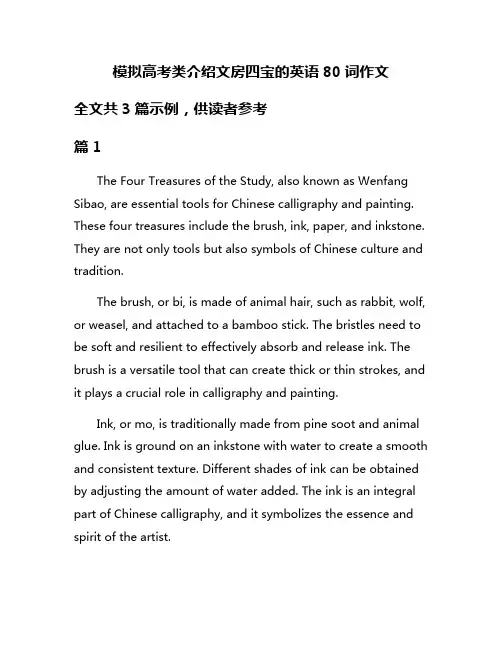
模拟高考类介绍文房四宝的英语80词作文全文共3篇示例,供读者参考篇1The Four Treasures of the Study, also known as Wenfang Sibao, are essential tools for Chinese calligraphy and painting. These four treasures include the brush, ink, paper, and inkstone. They are not only tools but also symbols of Chinese culture and tradition.The brush, or bi, is made of animal hair, such as rabbit, wolf, or weasel, and attached to a bamboo stick. The bristles need to be soft and resilient to effectively absorb and release ink. The brush is a versatile tool that can create thick or thin strokes, and it plays a crucial role in calligraphy and painting.Ink, or mo, is traditionally made from pine soot and animal glue. Ink is ground on an inkstone with water to create a smooth and consistent texture. Different shades of ink can be obtained by adjusting the amount of water added. The ink is an integral part of Chinese calligraphy, and it symbolizes the essence and spirit of the artist.Paper, or zhi, is typically made from mulberry tree bark, bamboo, or rice straw. Chinese calligraphy paper is thin, strong, and absorbent, allowing the ink to flow smoothly and evenly. The quality of paper affects the final outcome of calligraphy and painting.The inkstone, or yan, is a flat stone slab used for grinding ink. It is often carved with intricate designs or poetry, adding an aesthetic element to the writing process. The inkstone is a symbol of wisdom and patience, as it requires skill and time to grind the ink properly.In conclusion, the Four Treasures of the Study are not just tools but also symbols of Chinese art and culture. They require skill, patience, and dedication to use effectively, and they are cherished by calligraphers and artists around the world.篇2Introduction to the Four Treasures of StudyThe Four Treasures of Study, also known as Wenfang Sibao in Chinese, refer to the essential tools used for traditional Chinese calligraphy and painting. These four treasures are the brush, ink stick, inkstone, and paper. Each treasure plays a vital role in the creation of traditional Chinese artworks.The brush, called the "bi" in Chinese, is made from animal hair such as goat, rabbit, or wolf. It comes in various sizes and shapes, each suitable for different styles of calligraphy and painting. The brush is the most important tool in Chinese art, as it allows artists to create strokes of varying thickness and texture.The ink stick, or "mo" in Chinese, is made from soot and animal glue. It is ground on an inkstone with water to create ink for painting and calligraphy. The quality of the ink depends on the texture and smoothness of the ink stick, as well as the skill of the artist in grinding the ink.The inkstone, or "yan" in Chinese, is used to grind the ink stick and water together to create ink. It is usually made from stone, ceramic, or clay, and comes in various sizes and shapes. The inkstone is an essential tool for artists, as it determines the quality and consistency of the ink used in artworks.The paper, or "zhi" in Chinese, is made from various materials such as bamboo, rice straw, or mulberry bark. Traditional Chinese paper is thin, absorbent, and durable, making it ideal for calligraphy and painting. Artists choose different types of paper based on the specific needs of their artwork.In conclusion, the Four Treasures of Study are indispensable tools for traditional Chinese calligraphy and painting. These treasures have been used for centuries by artists to create beautiful and expressive artworks. The brush, ink stick, inkstone, and paper each play a unique role in the artistic process, making them essential items for any aspiring artist.篇3Nowadays, with the advent of modern technology, many traditional Chinese cultural practices are gradually being replaced by more convenient alternatives. However, there are still some traditions that hold a special place in the hearts of many Chinese people. One such tradition is the use of the four treasures of the study, also known as the "wenfang si bao".The four treasures of the study are essential tools for any scholar or calligrapher, and they have been a symbol of knowledge and creativity for centuries. These treasures include the brush, the ink stick, the ink stone, and the paper. Each of these items plays a unique role in the process of writing or painting, and together they form a harmonious balance that allows the artist to express themselves fully.The brush, or "bi", is perhaps the most important of the four treasures. Made from various materials such as animal hair or plant fibers, the brush is used to create intricate Chinese calligraphy and paintings. The ink stick, or "mo", is used to create the ink that is applied to the brush. The ink stick is made from a mixture of charcoal and other ingredients, and it is ground against the ink stone, or "yan", to create a smooth and consistent ink.The ink stone is a flat, rectangular surface that is used to grind the ink stick and mix it with water to create the perfect consistency for writing or painting. Finally, the paper, or "zhi", is the surface on which the artist works. Traditional Chinese paper is made from bamboo or mulberry fibers, and it has a unique texture that allows the ink to flow smoothly and evenly.In conclusion, the four treasures of the study are not just tools for writing or painting, but symbols of Chinese culture and tradition. They represent the harmony between nature and creativity, and they inspire artists and scholars to express themselves in new and meaningful ways. So, next time you pick up a brush to write or paint, remember the ancient tradition of the wenfang si bao, and let the spirit of the four treasures guide your hand.。
文房四宝中文:文房四宝(Four Treasures of the Study)也就是笔、墨(ink-stick)、纸、砚(ink-slab)是中国独具特色的文书工具。
“文房”之名,始于南北朝时期(the Northern and Southern Dynasties),专指文人(literati)书房而言。
四宝品类繁多,丰富多彩,以湖笔、徽墨、宣纸、端砚著称,享负盛名。
故宫博物院(the Palace Museum)收藏的文房四宝多为清代(the Qing Dynasty)名师所作,皇家御用,用料考究、工艺精美,代表了我国数千年来文房用具的发展水平。
语言要点:characteristics; refer to; be famous for; collect; exceptionally; exclusively译文:The Four Treasures of the Study, namely the writing brush, ink-stick, paper and ink-slab, are the writing tools with Chinese characteristics. They got their names in the Northern and Southern Dynasties, referring only to the study of the literati. The Four Treasures, varied and colorful, are famous for theirhubi, huimo, xuanzhi, and duanyan. Those collected in the Palace Museum are famous products of masters of the Qing Dynasty, which, boasting exceptionally fine materials and superb craftsmanship, were used exclusively in the Royal Palace, representing the level of development of Chinese writing tools over several thousand years.。
文房四宝的英语作文The Four Treasures of the Study, also known as the Four Jewels of the Study, are the brush, ink, paper, and inkstone. These are the essential tools for traditional Chinese calligraphy and painting. The brush is made of animal hair, such as rabbit, goat, or wolf, and has a long history in China. It is used for writing and painting, and different brushes are used for different purposes.Ink is an important part of the Four Treasures of the Study. It is traditionally made from soot, mixed with glue and scented oils. The ink is ground on an inkstone with a small amount of water to produce the ink for writing or painting. The process of grinding ink is considered an art form in itself, and skilled calligraphers and painters are often admired for their ability to create beautiful ink.Paper is another essential part of the Four Treasures of the Study. Traditional Chinese paper is made from the bark of the mulberry tree and has a smooth, absorbent surface that is ideal for calligraphy and painting. Different types of paper are used for different purposes, such as rice paper for calligraphy and silk paper for painting.The inkstone is the final part of the Four Treasures of the Study. It is used to grind the ink and is often made of stone or ceramic. Theinkstone is an important tool for calligraphers and painters, and skilled artists often have a collection of inkstones for different types of ink and different styles of writing and painting.In conclusion, the Four Treasures of the Study are essential tools for traditional Chinese calligraphy and painting. The brush, ink, paper, and inkstone are each important in their own way, and skilled artists often have a deep appreciation for the history and artistry of these tools.。
文房四宝英语作文The Four Treasures of the Study, also known as "Wen Fang Si Bao" in Chinese, refer to the essential tools used in traditional Chinese calligraphy and painting. These treasures are the brush, ink, paper, and inkstone. Each element has a rich cultural significance and history that is deeply intertwined with Chinese art and literature.The brush, or "bi," is a tool that has been crafted withgreat care and precision. Made from a variety of materials such as animal hair, bamboo, or even porcelain, brushes are designed to produce different strokes and effects on paper. The art of brush-making is itself a refined craft, with each brush requiring a skilled artisan to create.Ink, known as "mo," traditionally comes in the form of solid ink sticks. These sticks are made from soot and animal glue, and they are ground on an inkstone with water to produceliquid ink. The quality and color of the ink can vary greatly, affecting the final look of the calligraphy or painting. Ink has been a medium for expression in Chinese art for centuries, with each artist leaving their unique mark on history.Paper, or "zhi," is another critical component of the Four Treasures. The most famous variety is Xuan paper, which is known for its durability and ability to absorb ink without smudging. This type of paper is particularly favored for its texture and the way it interacts with the ink, allowing for awide range of artistic techniques.Lastly, the inkstone, or "yan," is a flat, smooth stone used for grinding the ink stick with water. It is typically made from materials like slate or ceramic and is often adorned with intricate carvings. The inkstone is not just a practical tool but also a piece of art in its own right, reflecting the aesthetic values of the time.Together, these Four Treasures form the foundation of traditional Chinese calligraphy and painting. They are not only tools for creating art but also symbols of Chinese culture and philosophy. The act of using these treasures is a meditative process that requires patience, skill, and a deep understanding of the materials. Each stroke of the brush on paper is a testament to the artist's mastery and the beauty of the Four Treasures of the Study.。